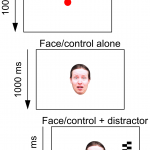Human infants display a very early-emerging preference toward faces and face-like stimuli, which promotes specialization of cortical circuits for processing important social information from faces, such as identification of different individuals and emotional expressions.
In this series of studies, we wanted to further investigate the development of emotion processing from faces in infancy. Our aim was to use eye movement based and psychophysiological methods to characterize how attention to positive and negative facial emotions changes during the first year and explore the potential factors affecting infants’ attention to emotional faces (e.g., the role of previous experience with or the novelty of certain facial expressions).
In brief, these studies suggested that particularly during the second half of the first year, infants develop a strong attentional bias toward faces expressing fear. This attentional bias is expressed as a longer dwell time on fearful faces when they compete for attention with other emotions or non-emotional stimuli, and also as larger neural and physiological responses to fearful faces (i.e., event-related potentials of the EEG and heart rate deceleration, respectively). The results comparing fearful faces to different control stimuli also suggested that the attention bias to fearful faces is not solely due to the unfamiliarity or novelty of fearful faces for the infants, as control stimuli displaying no clear emotional signals but sharing some of the visual characteristics of fearful faces did not attract infants’ attention similarly as prototypical fearful faces.

These studies have since inspired a great deal of further research both in Tampere and internationally, and the attention paradigm for assessing infants’ attention to faces is currently being used by multiple laboratories all over the world. Our own subsequent studies in collaboration with the Infant Cognition Lab have especially focused on the factors that may affect individual differences in infants’ attention to faces and facial emotions (e.g., Forssman et al., 2014), and the predictive significance of individual differences in infants’ attention to faces on later social and emotional development (e.g., Peltola et al., 2015, Peltola et al., 2018).
Funding: Academy of Finland, Finnish Cultural Foundation, Emil Aaltonen Foundation, Finnish Doctoral School of Psychology
Researchers: Mikko Peltola, Jukka Leppänen, Jari Hietanen
Key publications:
Peltola, M. J., Leppänen, J. M., Palokangas, T., & Hietanen, J. K. (2008). Fearful faces modulate looking time and attention disengagement in 7-month-old infants. Developmental Science, 11(1), 60–68. doi:10.1111/j.1467-7687.2007.00659.x Fulltext
Peltola, M. J., Leppänen, J. M., Mäki, S., & Hietanen, J. K. (2009). Emergence of enhanced attention to fearful faces between 5 and 7 months of age. Social Cognitive and Affective Neuroscience, 4(2), 134–142. doi:10.1093/scan/nsn046 Fulltext
Peltola, M. J., Leppänen, J. M., Vogel-Farley, V. K., Hietanen, J. K., & Nelson, C. A. (2009). Fearful faces but not fearful eyes alone delay attention disengagement in 7-month-old infants. Emotion, 9(4), 560–565. doi:10.1037/a0015806 Fulltext
Leppänen, J. M., Peltola, M. J., Mäntymaa, M., Koivuluoma, M., Salminen, A., & Puura, K. (2010). Cardiac and behavioral evidence for emotional influences on attention in 7-month-old infants. International Journal of Behavioral Development, 34(6), 547–553. doi:10.1177/0165025410365804
Peltola, M. J., Leppänen, J. M., & Hietanen, J. K. (2011). Enhanced cardiac and attentional responding to fearful faces in 7-month-old infants. Psychophysiology, 48(9), 1291–1298. doi:10.1111/j.1469-8986.2011.01188.x Fulltext
Peltola, M. J., Hietanen, J. K., Forssman, L., & Leppänen, J. M. (2013). The emergence and stability of the attentional bias to fearful faces in infancy. Infancy, 18(6), 905–926. doi:10.1111/infa.12013 Fulltext
